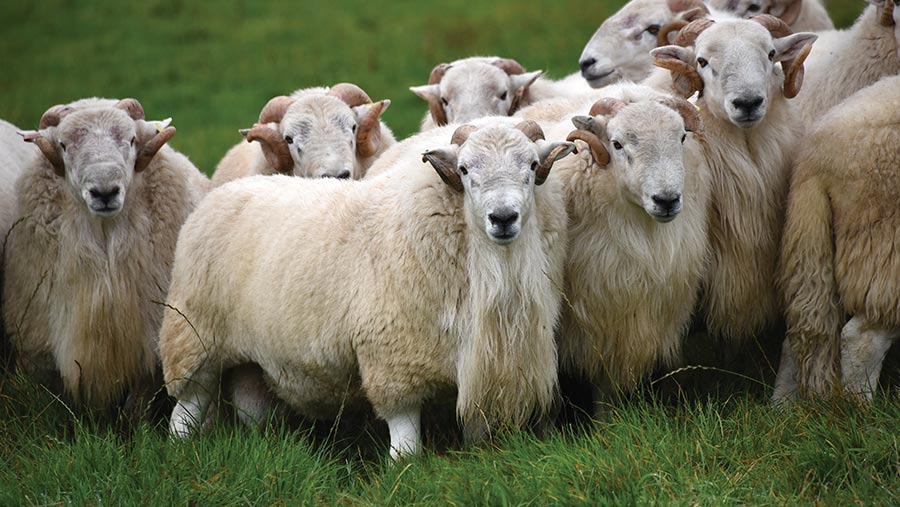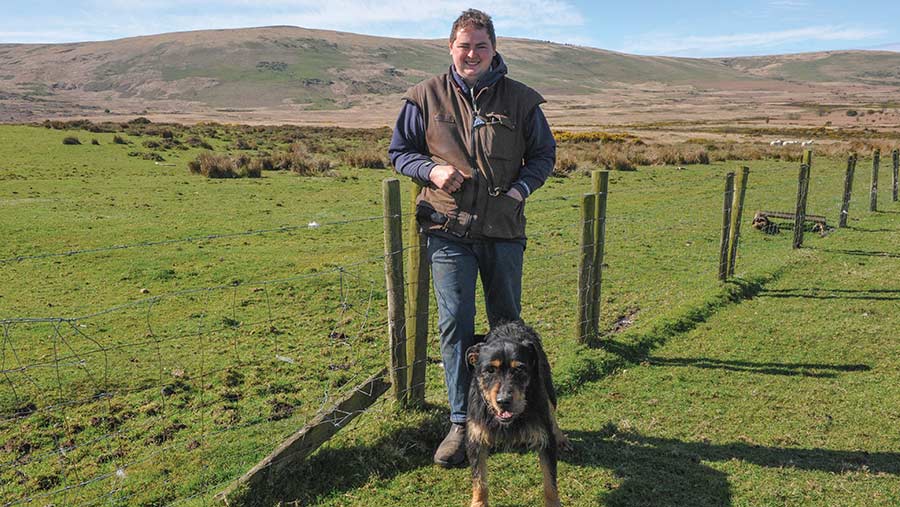How a Welsh hill farm is improving lambs’ finishing weights
 © Ruth Rees Photography
© Ruth Rees Photography Greater numbers of lambs produced from a Welsh hill flock are hitting finishing weights since performance recording was introduced to improve genetics across the entire flock.
The Davies family run 5,000 Tregaron-type Welsh Mountain ewes on the Preseli Hills at Eisteddfa Fawr, near Crymych, Pembrokeshire.
These are made up of two hefted flocks on a low-input system that feeds no concentrates.
“It can be tough land,” admits Dyfed Davies, who farms with his parents, Berian and Llinos, and uncle and aunt, Ken and Ceri Davies.
See also: The system that helps a sheep unit save £30,000 on feed
The breeding objectives have traditionally prioritised breed type and ewe type.
“We don’t want a ewe with a mature weight much beyond 60kg and, because of the weather conditions we experience on the hill, she must have a tight coat,” says Dyfed.
Historically, half the lambs were sold as stores, because they struggled to fatten on the hill land with its peaty, wet soils. In 2019, they started performance recording with Hybu Cig Cymru’s (HCC) Hill Ram Scheme.
Four breeding seasons in and there are already early signs of the “trickle-down effect” of genetic gains, including more lambs hitting slaughter weights.
Farm Facts: Eisteddfa Fawr
- 607ha (1,500 acres) farmed
- Grazing rights to 2,428ha (6,000 acres) of common land on the Preseli Hills
- Fat lambs sold to Pilgrim’s, Llanidloes, or liveweight through local markets
- Store lambs sold at Crymych Mart
Selecting flock replacements and tups based on backfat-scanning results is one reason for that improvement, says Dyfed.
“Animals with high levels of backfat tend to be easier fleshing and fattening and have better milk production.
“We could finish more lambs by introducing concentrates or with heavier use of fertiliser, but by selecting on backfat scores and other traits, we are producing quicker finishing lambs off what are relatively poor pastures.”
Maternal traits important in the hill ewe can take many generations to filter through.
However, he is already seeing improvements, with 10% more lambs sold as fat in 2022 compared with numbers before performance recording.
“If we can achieve a better carcass in less time with no bought-in feed, it will help farm profitability,” Dyfed reasons.
Fat lambs are sold at an average deadweight of 19kg from mid-October until Christmas; lambs that do not finish are sold as stores during this period.

Dyfed Davies © Debbie James
Tissue sampling breakthrough
He saw performance recording as a means of complementing those objectives, but a barrier to that – especially for recording parentage – was the large number of ewes in the flock and the extensive system, with all lambing outdoors.
Tissue Sampling Unit (TSU) technology offered through the Hill Ram Scheme, with HCC meeting the sampling cost, provided that opportunity.
This allows larger numbers of sheep to be easily recorded in their natural environment.
“Tissue sampling was the only way we could do it,” says Dyfed. “The funding was important too, because initially we needed to sample the whole flock and that would have been a big financial outlay.”
As a result, 10% of the flock is now performance recorded.
The best-looking yearlings by type – a total of 350 – were initially selected and replacements have been bred from those since 2019.
Their progeny are fitted with electronic identification (EID) tags and DNA samples taken from their ears. The analysis of the DNA is matched to that of the ewes and allows parentage to be assigned.
The Davies’s focus is on the maternal ability of ewes, with lamb weights and backfat levels recorded at eight weeks and 20 weeks. Having those figures allows them to make better breeding decisions.
Replacement strategy
To drive genetic gains, better-performing ewe lambs are retained as replacements and as tups for home use or to sell as breeding rams.
This forms part of the farm’s long-term strategy to produce hardy and efficient replacements and heavier lambs without introducing concentrates or heavy use of fertiliser.
“It is very hard to make money in a hill system like ours if you introduce a lot of cost,” Dyfed says. “By improving genetics across the entire flock, the hope is that we can produce more from the same inputs as before.
“We are still at the early stages because it is a long-term project, but we are just starting to see improvements.”
Fat depth on ewe lambs has increased by 4%, which he describes as a “small gain but heading in the right direction”.
Low-hanging fruit
Dyfed believes the biggest genetic gain comes from using rams with high figures born out of the performance-recorded flock as sires on his commercial Welsh Mountain ewes.
“That is where we see most of our genetic gain in commercial ewes – the ‘low-hanging fruit’.”
To maximise genetics from these recorded rams, at tupping he runs one ram to 100 ewes with superior phenotypes and genotypes; for other rams, he uses a ratio of 1:60.
The tups are turned in with the ewes in mid-October for six weeks.
Scanning rate averaged 130% in the 2022 breeding season, and the target with genetic improvement is to lift it above 150%.
“We could scan at 150% or higher if we used a lot of fertiliser and flushed ewes, but it wouldn’t be financially viable because of the cost and the low output of a ewe compared with a dairy cow,” says Dyfed.
Ewes lambs from mid-March to mid-April – of the 5,000 ewes that lambed in 2023, only 100 or so needed assistance.
Foot health
Over the past five years, an emphasis has also been placed on improving foot health, with a policy of strict culling for lameness.
Any animal that has been handled once for foot treatment is taken out of the performance-recorded flock.
“We run a lot of sheep with a low labour unit, so the sheep need to work for themselves. If we had to handle them frequently to treat their feet, it would make it a lot harder for us to manage,” says Dyfed.
Any ewe that is removed from the recorded flock because of lameness, difficulty with lambing or with a poor coat is sired to a Hampshire Down ram.
“The Hampshire Down is naturally easy fleshing, fatter and easier to finish on our type of pasture, so it suits us as a terminal sire,” he says.
Grazing policy
The business has adapted to the shrinking availability of tack land for wintering sheep.
In the past 10 years, a significant acreage of winter keep has been lost from the system, in part because of a movement towards multi-cut silaging and earlier first cuts.
As an alternative, the Davies’ flock now strip grazes 22ha (55 acres) of fodder beet on an arable farm under a grazing agreement; the crop is a good fit for that farm’s arable rotation.
Ewe lambs are wintered on deferred grazing supplemented with big bale grass silage.
Bales are made from the first crop of silage and left in situ and a bank of grass builds up around them. This too is strip grazed.
